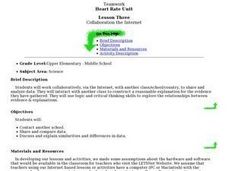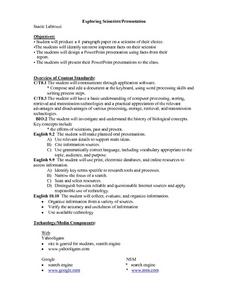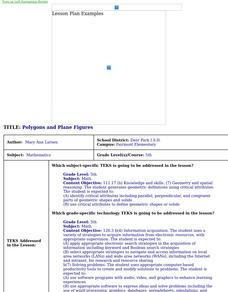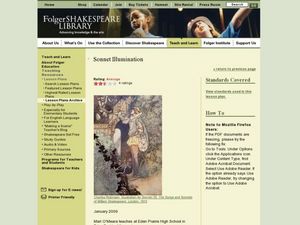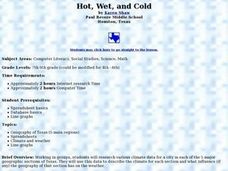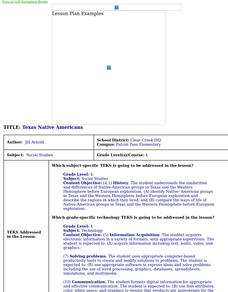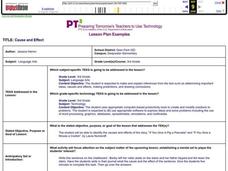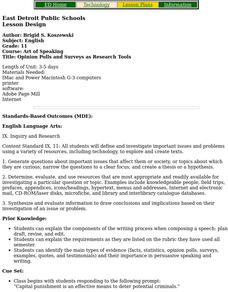Curated OER
The Study of the Spanish-Speaking People of Texas: Daily Life
High schoolers analyze the different ways that photography helps historians understand the lives of people who lived in the past. They examine images from Russell Lee's photo essay and discuss how Texas' has changed from an agrarian to...
Curated OER
Sorting Quadrilaterals
Tenth graders investigate the geometric concept of quadrilaterals. They are given a set of shapes and asked to sort the quadrilaterals from the others. Then working in pairs they discuss the characteristics and write down the description...
Curated OER
Classroom Heart Rates
Students check and record heart-rates of other classmates. They compare and design questions to explain the differences in their findings. Possible explanations might include: the effects of culture, lifestyles, age and gender on heart...
Curated OER
Bill Irwin: All in a Day's Work
Young scholars perform for an audience. In this performing arts lesson, students explore the work of actor Bill Irwin in a variety of roles. Young scholars direct and perform a fairy tale in small groups .
Curated OER
The Human Body: Focusing on Respiratory and Circulatory Systems
Students study the components and functions of the respiratory and circulatory systems. They take blood pressure using a stethoscope and investigate ways to maintain a healthy respiratory system.
Curated OER
Counting Fat in Our Diet
Students take home a fat diary and, with the help of their parents, keep track of how much fat they ingest every day. The fat diary should include entries for each day, as well as items eaten, servings, and total fat intake.
Curated OER
Collaboration the Internet
Students work collaboratively, via the Internet, with another class/school/country, to share and analyze data. They nteract with another class to construct a reasonable explanation for the evidence they have gathered.
Curated OER
Choosing the Lincoln Statue
Fourth graders research photographs or artwork depicting Abraham Lincoln during the time when he was traveling the 8th Judicial Circuit and practicing law in Champaign County. They develop a Powerpoint presentation of the results of the...
Curated OER
The Ultimate Vacation
Students use research skills to solve a problem. They research information needed to plan a vacation. Students create a letter, a flyer, an itinerary, an activity list, cost spreadsheet, a reference page, table of contents and a title page.
Alabama Learning Exchange
Is My Water Safe?
Learners discuss what makes their drinking water safe and unsafe. They locate and visit a local tributary and test the water's pH, hardness, dissolved oxygen, and total alkalinity. They compose a summary paragraph about the tests and...
Curated OER
How Animals Meet Their Needs
Fourth graders research the Internet for facts relating to the animal of their choice. They use information from their Internet search to complete their animal project. TLW use his or her own words when writing their report.
Curated OER
Exploring Scientists/Presentation
Students research a scientist of their choice. They write a research paper on him or her. They select ten important facts from their research paper and prepare a PowerPoint presentation using their facts.
Curated OER
Polygons and Plane Figures
Students choose a polygon to define and describe, and use Power Point and the Internet to present their polygon.
Curated OER
Quadratic Modeling Of Canada's Baby Boom
Students model quadratic equations. In this algebra lesson, students are given data to graph using a function. They investigate vertex and transformation of quadratic functions.
Curated OER
Critical Reading: Intelligence Augmentation
In this critical reading worksheet, students read a short passage regarding intelligence augmentation and then answer five questions based on the reading.
Curated OER
Sonnet Illumination
Students create presentations of digital sonnet illuminations along with sonnet research. In this Sonnet lesson, students view images, colors, and listen to sounds of their own choice to illuminate Shakespeare...
Curated OER
Hot, Wet, and Cold
Students research climate data for a city in each of the 5 major geographic sections of Texas. They use data to describe the climate and what influence the geography of that section has on the weather.
Curated OER
Simple Machines
Third graders examine and identify the six types of simple machines. Using a model of each simple machine, they demonstrate the state the function of them to the class. They discover examples of simple machines at school and home and...
Curated OER
Texas Native Americans
Fourth graders research the Native Americans of Texas using the Internet. They create a Power Point presentation over the four Indian tribes of Texas - Caddo, Jumano, Karankawa, Apache.
Curated OER
Cause and Effect
Third graders identify the causes and effects of the story, "If You Give A Pig a Pancake" and "If You Give a Mouse a Cookie", by Laura Numeroff. They write a cause and effect story using Kidspiration.
Curated OER
Anne Frank: Timeline
Eighth graders become acquainted with major events, especially related to the life and times of Anne Frank and compare personal and family chronology to Twentieth Century events. They examine how discrimination existed in the past and...
Curated OER
Opinion Polls And Surveys As Research Tools
Eleventh graders determine, evaluate, and use resources that are most appropriate and readily available for investigating a particular question or topic. Examples include knowledgeable people, field trips, prefaces, appendices,...
Curated OER
Virginia: The Land and its First Inhabitants
Students review the five geographical regions of the state of Virginia. Using a map, they locate and label Virginia, surrounding states and the crops grown in the area. They present their map to the class and complete a worksheet to end...
Curated OER
Mapping Lab and Lead Poisoning
Students are introduced to GIS and its uses. They make predictions before viewing the actual lead poisoning cases by location of Dade County. Pupils use actual Miami-Dade County spatial data to explore basic principals. Students






